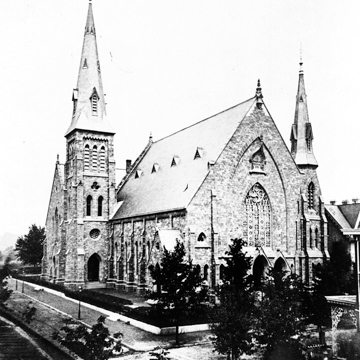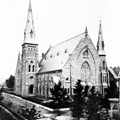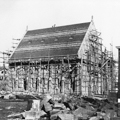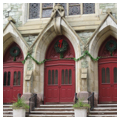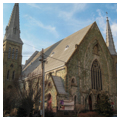Here is Delaware's best surviving example of High Victorian Gothic, a richly ornamental mode imported from England. The style was short-lived and many examples have been demolished, making this one especially valuable. An enthusiastic Sunday School association emerged at St. Paul's Methodist at 7th and Market streets in the early 1860s, organizing mission work in poor neighborhoods. The wealthy leaders of the group, including the heads of Jackson and Sharp Car Works and Harlan and Hollingsworth (WL8), wished to expand the campaign but met with resistance at St. Paul's. They formed a new congregation in 1864 and set out to build Delaware's finest church. Architect Dixon, a Wilmingtonian who moved to Baltimore, had added a tower to nearby St. Andrew's (WL43). Ground was broken in April 1865 on the Chapel—the section of Grace Church to the west—where the first service was held in March 1866, in the Upper Room (600 seats). The raising of the spire that year was considered an exceptional feat, recorded in photographs. The main body of the church, or sanctuary (800 seats), opened in January 1868. It bears a plaque outside, “A Centenary Offering 1866,” referring to the 100th anniversary of Methodism. The Chapel was then put to Sunday school uses.
Polychromy, the use of intrinsically colorful building materials, is fundamental to High Victorian Gothic. Dixon used serpentine, a green stone from Brinton's Quarry near West Chester, Pennsylvania, a few years in advance of its great, though fleeting, regional popularity. Reddish Connecticut brownstone forms the lowest courses, and the trim is buff New Brunswick, New Jersey, sandstone. The serpentine and brownstone have deteriorated badly, owing in part to twentieth-century sandblasting. Grace Church bears comparison with Dixon and Charles L. Carson's serpentine Mount Vernon Place Methodist Episcopal Church, Baltimore (1872), similar in plan though with a different arrangement of towers. Both churches would have been at home in Great Britain in the 1860s, showing close affinities to the work of architect George Gilbert Scott and his contemporaries, which in turn was inspired by architect A. W. N. Pugin. The detailing of Grace Church's stone walls and its intricate, historically accurate Gothic Revival window shapes are fascinating to study, with so much variety and deliberate contrast.
Some original stained glass windows survive, splendid examples of tracery and fiery with ruby-reds and purples. The big window over the gallery in the sanctuary was recently restored; equally valuable, though rarely visited, are the somewhat similar windows in the now-empty Upper Room and the round windows in the disused tower. The lancets along the side walls of the sanctuary were replaced in 1913–1914 with muted, opalescent-glass copies of famous religious paintings (William Reith Studios, Philadelphia). An apsidal stained glass window is extraordinary, lit from behind, originally with sixty lightbulbs, now by fluorescent tubes. Given by Melville Gambrill and his wife, it stands nearly thirty feet high, weighs more than two tons, and contains 18,000 pieces of glass, with its subject being “Come Unto Me” (1924, H. B. Hankinson and Charles Mente). The church received an addition in 1942, and the original polychrome slate roofs were replaced with unaesthetic gray metal in 1949. In 1995, the sanctuary floor plan was altered to allow better visibility for arts performances, the urban congregation now emphasizing such activities to boost community involvement. A major addition (2001, Anderson Brown Higley Associates) unfortunately included removal of a set of triple lancet windows in the Upper Room, so distinctive of English Gothic; worse, it involved destruction of the serpentine stone parsonage adjacent to the church, Bassett Hall (c. 1890, Baker and Dallett).


